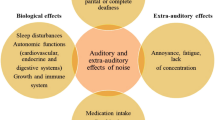Abstract
In present study, two adaptive neuro-fuzzy models have been developed for traffic classification and noise prediction, respectively. The traffic classification model (ANFIS-TC) classifies extracted sound features of different categories of vehicles based on their acoustic signatures. The model also compute total number of vehicles passes through a particular sampling point. The results have been used for the estimation of the equivalent traffic flow (\(Q_\mathrm{E})\). The noise prediction model (ANFIS-TNP) has three inputs, namely equivalent traffic flow (\(Q_\mathrm{E})\), equivalent vehicle speed (\(S_\mathrm{E})\) and honking. The equivalent traffic flow (\(Q_\mathrm{E})\) is the output of ANFIS-TC model, while equivalent vehicle speed (\(S_\mathrm{E})\) and honking are computed from observed averaged speed of different categories of vehicles and number of recorded horns blow per minute. The model assumes that the distance between sound level meter and road centerline is fixed for particular sampling point. The performance of both the models has been validated by field observations. The results show that traffic classification is 100% accurate, while correlation coefficients between observed and predicted traffic noise range from 0.75 to 0.96. Both the models are validated with random samples of data, and it is observed that both the models are generalized and could be employed for traffic classification and traffic noise prediction in small urban heterogeneous traffic environment for noise pollution assessment and control.








Similar content being viewed by others
References
Arora JK, Mosahari PV (2012) Artificial neural network modeling of traffic noise in Agra-Firozabad Highway. Int J Comput Appl 56(2):0975–8887
Averbuch A, Hulata E, Zheludev VA, Kozlov I (2001) A wavelet packet algorithm for classification and detection of moving vehicles. Multidimens Signals Signal Process 12(1):9–31
Bin J, Rui J, Qing-Song W, Mao-bin H (2005) Honk effect in the two lane cellular automaton model for traffic flow. Phys A 348:544–552
Borkar P, Malik LG, Sarode MV (2014) Acoustic signal based traffic density state estimation using adaptive neuro-fuzzy classifier. In: WSEAS Transactions on Signal Processing, E-ISSN: 2224–3488, vol 10, pp 51–64
Genaro N, Torija A, Ridao AR, Requena I, Ruiz DP, Zamorano M (2010) A neural network based model for urban noise prediction. J Acoust Soc Am 128(4):1738–1746
George J, Cyril A, Koshy BI, Mary L (2013) Exploring sound signature for vehicle detection and classification using ANN. Int J Soft Comput 4(2):29–36
Hall MA, Holmes G (2000) Benchmarking attribute selection techniques for data mining. Working paper series, ISSN 1170-48X, Department of Computer Science, The University of Waikato, New Zealand
Hastie T, Tibshirani R, Friedman J (2009) The elements of statistical learning: data mining, inference, and prediction, 2nd edn. Springer, New York
Huadong W, Siegel M, Khosla P (1999) Vehicle sound signature recognition by frequency component analysis. In: Proceedings of IEEE transaction on instrumentation and measurement, vol 48, pp 1005–1009
Huang Q, Xing T, Hai TL (2006) Vehicle classification in wireless sensor networks based on rough neural network. In: Proceedings of ACST, pp 141–144
Kalaiselvi R, Ramachandraiah A (2010) Environmental noise mapping study for heterogeneous traffic conditions. In: Proceedings of 20th International Congress on Acoustic. ICA, Sydney, Australia, pp 23–27
Matlab (2010) http://mathwork.com
Mishra RK, Parida M, Rangnekar S (2010) Evaluation and analysis of traffic noise along bus rapid transit system corridor. Int J Environ Sci Technol 7(4):737–750
Nanda SK, Tripathy DP, Patra SK (2008) Fuzzy inference system-based noise prediction models for opencast mines. Int J Min Reclam Environ 23(4):242–260
Nayef MA, Rukaibi AF (2012) Neural network models for traffic noise quality prediction: a comparative study. J Civil Environ Eng. doi:10.4172/2165-784X.1000106
NCH WavaPad, Sound Recording Software version 5.60 (2013) http://www.nch.com.au/wavepad/index.html
Nooralahiyan AY, Kirby HR (1998) Vehicle classification by acoustic signature. Math Comput Model 27(9–11):205–214
Rajakumara HN, Gowda RMM (2009) Road traffic noise prediction model under interrupted traffic flow condition. Environ Model Assess 14:251–257
Sharma A, Vijay R, Sardar VK, Sohony RA, Gupta A (2010) Development of noise simulation model for stationary and model sources: a GIS approach. Environ Model Assess 15(3):189–197
Sharma A, Bodhe GL, Schimak G (2014) Development of a traffic noise prediction model for an urban environment. Noise Health 16(68):63–67
Shukla K, Jain SS, Parida M, Srivastava JB (2009) Performance of FHWA model for predicting traffic noise: a case study of Metropolitan city, Lucknow (India). Transport 24(3):234–240
Steele C (2001) A critical review of some traffic noise prediction models. Appl Acoust 62(3):271–287
Thomas DW, Wilkins BR (1972) The analysis of vehicle sounds for recognition. Pattern Recognit 4:379–389
Wani KA, Jaiswal YK (2010) Assessment of noise pollution in Gwalior, M.P, India. Adv Biores 1(1):54–60
Weka 3, Data Mining Software (2013) http://www.cs.waikato.ac.nz/ml/weka/
Acknowledgements
The authors are grateful to the Director, CSIR-National Environmental Engineering Research Institute for providing encouragement, necessary infrastructure to carry out the research and kind permission to publish the paper.
Author information
Authors and Affiliations
Corresponding author
Ethics declarations
Conflict of interest
The authors declare that they have no conflict of interest.
Additional information
Communicated by V. Loia.
Rights and permissions
About this article
Cite this article
Sharma, A., Vijay, R., Bodhe, G.L. et al. An adaptive neuro-fuzzy interface system model for traffic classification and noise prediction. Soft Comput 22, 1891–1902 (2018). https://doi.org/10.1007/s00500-016-2444-z
Published:
Issue Date:
DOI: https://doi.org/10.1007/s00500-016-2444-z




